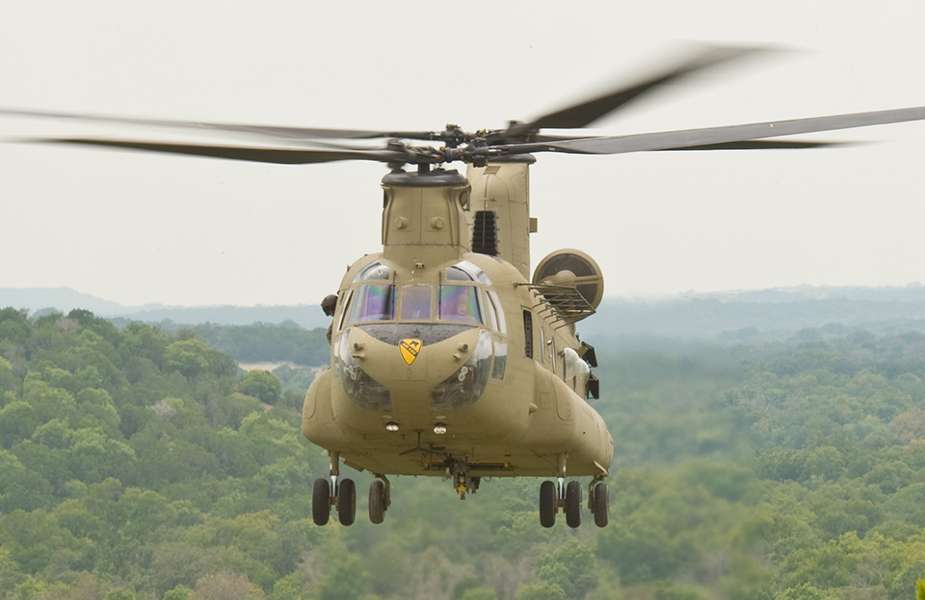On April 11, 2024, the Republic of Singapore Air Force (RSAF) reached an important step as its H225M and CH-47F helicopter fleets each achieved Full Operational Capability (FOC). These aircraft, which replace the older AS332M and CH-47D models, are now fully integrated into the RSAF's medium and heavy-lift operations.
Follow Army Recognition on Google News at this link

Airbus H225M tactical transport helicopter (Picture source: Airbus)
The helicopters are operated by RSAF's 125, 126, and 127 Squadrons, and their operational ramp-up was supported by the Oakley Detachment in Australia, as well as the Singapore Army and Navy. This successful integration highlights the importance of collaboration among the different branches of Singapore's armed forces.
Singapore's Minister of Defence, Ng Eng Hen, officially announced this achievement on April 11, 2024, emphasizing the significant enhancements these platforms bring to the RSAF. "These two new helicopter platforms go beyond improving our air capabilities; they strengthen the integration among services, thereby enhancing our logistical support to land and naval forces," Minister Ng explained.
The extended capabilities of the H225M and CH-47F allow the RSAF to enhance its operations across several critical areas. In addition to traditional troop and equipment transport missions, these helicopters are equipped for search and rescue operations, medical evacuation, counterterrorism, and humanitarian assistance and disaster relief missions. These strategic additions are crucial for an armed force that is playing an increasingly global role.
The operational readiness of these fleets marks a key step in the RSAF's modernization plan, ensuring that the force remains equipped to meet contemporary and future defense and security challenges.
H225M
The Airbus Helicopters H225M, formerly known as the Eurocopter EC725 Caracal, is a tactical transport helicopter developed from the Eurocopter AS532 Cougar. The twin-engined H225M helicopter can carry up to 28 troops and two crew members depending on configuration and is intended for troop transport, casualty evacuation, and combat search and rescue missions. It shares similarities with the civilian EC225 Super Puma.
The development of the EC725 was initiated to fulfill the requirements of the French Air Force for a helicopter specialized in Combat Search and Rescue (CSAR) operations. It included enhancements over the AS532 Cougar, such as more powerful engines, increased flight endurance, and improved durability for combat scenarios. The prototype of the EC725 flew on November 27, 2000, and the first delivery to the French Air Force was in February 2005. A civilian variant, the EC225, was developed alongside the military-oriented EC725.
The H225M features a five-blade composite main rotor designed to reduce vibration. It is powered by two Turboméca Makila 1A4 turboshaft engines, which include a dual-channel full authority digital engine control (FADEC) system. The aircraft can be optionally equipped with an anti-icing system for operations in cold climates. The helicopter also incorporates a reinforced main rotor gearbox and a cockpit with an integrated display system, featuring a digital map and active-matrix liquid-crystal displays.
The armament options for the H225M are varied, allowing it to be equipped with machine guns, rocket launchers, torpedoes, and missile systems such as Hellfire missiles. Additionally, it can be fitted with countermeasures against radar and heat-guided missiles. The helicopter is available in different configurations, including troop transport, VIP transport, casualty evacuation, and Combat SAR, tailored to specific mission needs. The H225M is designed to perform a range of missions, including tactical transport, aeromedical transport, and maritime operations. Its specifications include a cruise speed of 262 km/h and a maximum range of up to 1,253 km with auxiliary fuel tanks.
CH-47F
The CH-47F Chinook, a highly advanced model of the CH-47 series, first entered production in the early 2000s with its initial entry into service in 2007. Developed by Boeing for the United States Army and other defense forces worldwide, it is a twin-engine, tandem-rotor heavy-lift helicopter. Designed for troop movement, artillery placement, and battlefield resupply, the CH-47F features significant upgrades over its predecessors, including an advanced cockpit management system, improved avionics, and an enhanced airframe for greater survivability. It boasts a top speed of 175 mph (282 km/h) and a maximum lift capacity of more than 21,000 pounds (9,525 kg), making it one of the most capable heavy-lift helicopters in operation today.
The CH-47F Block II represents an advancement in the Chinook helicopter line, focusing on increased payload capacity and improved performance under challenging conditions. Designed in 2020, this model was aimed to transport a payload of 22,000 pounds (about 10,000 kg) in high altitude and high-temperature conditions, specifically at 4,000 feet (about 1,200 meters) and 95 °F (35 °C), to increase this capability to 6,000 feet (about 1,800 meters). This enhanced capability allows the CH-47F Block II to transport Joint Light Tactical Vehicles, necessitating an increase in the maximum takeoff weight to 54,000 pounds (about 24,500 kg).
To achieve these ambitious goals, the CH-47F Block II is equipped with Honeywell T55-715 engines, which are 20% more powerful than their predecessors. It also incorporates an active parallel actuator system (APAS) that enhances the digital advanced flight control system, allowing for an exact torque split between the rotors for increased efficiency. In terms of fuel management, a system redesign consolidated the three fuel tanks in each sponsor into a single tank, reducing weight by 90 kg (200 pounds) while increasing fuel capacity.
The increase in electrical capacity is also notable, with the addition of three 60 kVA generators, thus enhancing the helicopter's versatility and operational capability. However, a significant aspect of the CH-47F Block II development was the decision not to implement the Advanced Chinook Rotor Blades (ACRB), derived from the canceled RAH-66 Comanche program. These blades were intended to improve lift performance in hot and high-altitude conditions by 2,000 pounds. Nevertheless, due to persistent vibration during testing, the US Army decided not to proceed with this innovation, despite Boeing's assertion that the vibration did not pose a safety risk and could be resolved with dampeners.

Boeing CH-47F tactical transport helicopter (Picture source: Boeing)
















